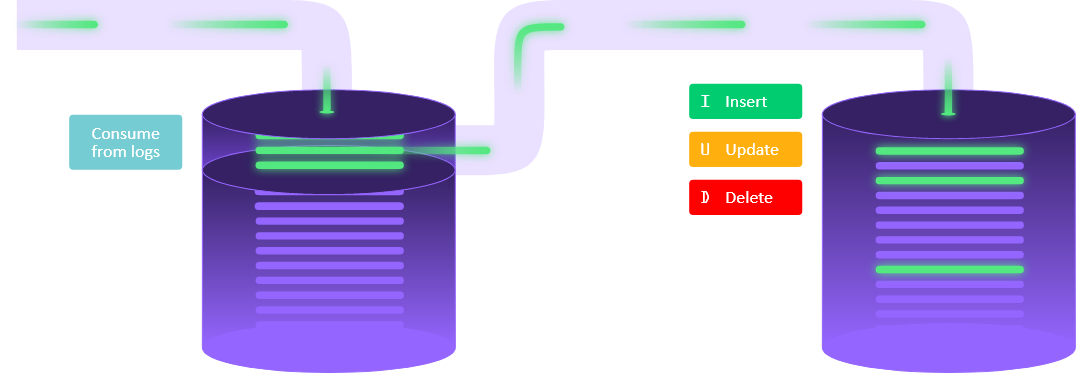What is Change Data Capture?
Change Data Capture (CDC) is a crucial process in the world of data management. It allows organizations to track and capture any changes made to their systems, ensuring that data replication is efficient, consitent and timely. In this guide, we will delve into the intricacies of CDC, exploring its definition, importance, key components, types, and implementation strategies.

Understanding Change Data Capture
Definition and Importance of Change Data Capture
Before we dive deeper into the topic, let's start by understanding what Change Data Capture actually means. In simple terms, CDC is a method used to identify and capture data changes that occur in a source system. These changes are then replicated and applied to a target system, ensuring that both systems are synchronized.
The importance of CDC cannot be overstated. It enables consistent and up-to-date data across multiple systems, tools, and products. By tracking changes as they happen, businesses can have a holistic view of their data, at both small and very large volumes.
Change Data Capture also plays a vital role in ensuring data integrity and compliance with regulatory requirements. By accurately capturing and recording data changes, organizations can provide a clear audit trail, which is essential for demonstrating data lineage and meeting legal obligations.
The Role of Change Data Capture in Data Management
Within the realm of data management, CDC plays a crucial role. It helps organizations address data synchronization challenges when dealing with heterogenous systems (databases, ERP, CRM ...), data lakes, data warehouses, and even real-time analytics. With CDC, enterprises can efficiently capture and propagate changes, eliminating data inconsistencies and minimizing overheads.
Moreover, Change Data Capture enhances data governance practices by providing visibility into who accessed, modified, or deleted specific data elements. This level of transparency not only improves data quality but also strengthens security measures by enabling organizations to track and respond to data breaches or unauthorized activities promptly.

Key Differences Between CDC and ETL
When it comes to data integration, two primary methods are often employed: CDC and Extract - Load (ETL or ELT). While CDC and ETL both serve the purpose of integrating data, there are several key differences that set them apart. Understanding these differences is crucial in determining which method is best suited for your specific requirements.
Let's delve deeper into these differences and explore the intricacies of CDC and ETL.
Operational Differences
ETL typically operates in batches, fetching large volumes of data at scheduled intervals. ETL is generally easier to set up at first as it does not require any configuration from the source systems (for instance setting up logging on a source data warehouse). It is however dependant on orchestration and scheduling and provides no concistency between two snapshots.
On the other hand, CDC operates by capturing and propagating individual changes as they occur. This means that as soon as a change is made to the source data, it is immediately replicated to the target system. CDC may require source configuration (for instance, enabling change tracking on a source database) but once set-up it is a passive process since changes are automatically propagated.
Performance Implications
When it comes to performance, CDC has a clear advantage. By capturing and transferring only the changed data, CDC significantly reduces the amount of data transferred and the processing time required. This can lead to faster data integration and improved overall system performance. The efficiency of CDC makes it very good at handling all matters of data velocity and volumes.
ETL, on the other hand, requires scanning the source system, which can be resource-intensive and impact system performance. The batch processing nature of ETL means that it may be sufficient for scenarios where immediate access to the most recent data is not required or where very large amounts can only be occasionally exported.
Data Latency
Data latency refers to the time delay between the occurrence of a data change and when it becomes available in the target system. CDC provides near real-time replication, ensuring minimal data latency. This is particularly important for organizations that require up-to-date data for critical applications and decision-making processes.
ETL, on the other hand, introduces a delay due to its batch processing nature. As data is processed in scheduled intervals, there is a time gap between when the data change occurs and when it becomes available in the target system. This delay can result in increased data latency, which may not be suitable for scenarios where reactivity matters.

Key Components of Change Data Capture
Source System
At the core of Change Data Capture (CDC) lies the source system where changes are made. This could be a relational database management system (RDBMS) like MySQL, PostgreSQL, or SQL Server, or any other data repository such as NoSQL databases like MongoDB or Cassandra, even an ERP, a CRM, or an event bus. The source system plays a crucial role in capturing and recording all modifications made to the data stored within, ensuring that every change is tracked and logged for further processing.
CDC Integrator
Implementing CDC requires the right technology stack. Specialized software or tools are needed to identify and extract the changes from the source seamlessly. These tools can vary from vendor-specific solutions like Oracle GoldenGate or IBM InfoSphere to third-party tools such as Popsink, StreamSets, or Striim. Each of these tools offers unique functionalities.
Furthermore, the choice of CDC technology should align with the scalability, performance, and compatibility needs of both the source and target systems. Factors like ease of use, cost, data transformation capabilities, and integration with existing data pipelines play a significant role in selecting the most suitable CDC solution for a particular use case.
Target Database
Once the changes are captured from the source system, they need to be propagated to a target system for further processing and analysis. The target system acts as the recipient of these changes, ensuring that data consistency is maintained across different systems. Depending on the nature of the data and the overall architecture, the target could be another RDBMS like Oracle Database or SQL Server, a cloud-based data warehouse like Clickhouse, Snowflake, BigQuery, or even a data lake, a CRM, an ERP, a microservice, or an AI model.
It is essential for the target database to support the same level of data integrity and reliability as the source database to guarantee seamless synchronization between the two. Additionally, proper data modeling, schema mapping, and conflict resolution strategies need to be in place to handle any discrepancies that may arise during the data replication process.
Strategic implications of CDC
Enabling Advanced Use Cases
CDC is the backbone for enabling advanced analytics and real-time applications. By providing immediate access to data changes, organizations can power real-time analytics, enabling predictive insights for more informed decision-making. For instance, financial institutions can detect fraudulent activities instantaneously, while retailers can adjust pricing dynamically based on real-time demand and supply insights. These capabilities allow businesses to be more agile, responsive, and predictive, rather than merely reactive.
Optimization of Operations and Resources
Operational efficiency is a vital benefit of CDC. By capturing only the changes in data, CDC minimizes the load on networks and databases, reducing costs associated with data storage and transfer. This efficient data handling translates into faster, more reliable operations and significantly lessens the impact on production systems, thereby optimizing overall business performance and resource utilization.
Facilitating Seamless Data Access and Integration
The integration of diverse systems and technologies is a common challenge for many organizations. CDC facilitates seamless data access and integration by ensuring that changes in one part of the organization's ecosystem are immediately available across the board. This real-time data synchronization supports a unified view of information, crucial for customer relationship management, supply chain coordination, and other integrated business processes, thus breaking down silos within an organization.
Ensuring Data Consistency Across Systems
In a world where data is scattered across various platforms and databases, maintaining consistency is paramount. CDC ensures that all systems reflect the most current data changes, thereby maintaining data consistency across the enterprise. This coherence is critical for accuracy in reporting, analytics, and operational processes, ensuring that decisions are made based on the latest information.
Aiding in Compliance and Data Governance
Lastly, CDC plays a pivotal role in compliance and data governance strategies. With regulations like GDPR and CCPA imposing stringent data handling requirements, the ability to track and audit data changes in real-time is invaluable. CDC provides an immutable log of data changes, aiding in the auditing process, and ensuring that organizations can meet regulatory requirements more efficiently.
In conclusion, the strategic implications of CDC for businesses are profound. By enabling advanced use cases, optimizing operations, facilitating seamless data access and integration, ensuring data consistency, and aiding compliance, CDC technology empowers businesses to not only navigate but thrive in the data-driven landscape of the 21st century. As organizations look to gain a competitive edge, the adoption of CDC could very well be the linchpin in their data management and analytics strategies.
